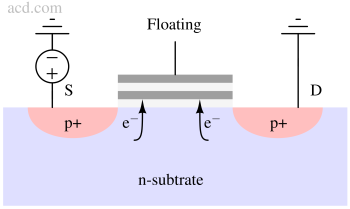Floating Gate MOSFET
What is Floating gate MOSFET?¶
A floating gate MOSFET (Metal-Oxide-Semiconductor Field-Effect Transistor) is a specialized type of MOSFET that features an electrically isolated gate terminal known as the floating gate. The primary purpose of the floating gate in a floating gate MOSFET is to store and control the amount of charge trapped within it. The presence or absence of charge on the floating gate alters the threshold voltage of the MOSFET, which affects its ID vs. VDS characteristics. This property enables the floating gate MOSFET to be used in non-volatile memory devices, such as EEPROM (Electrically Erasable Programmable Read-Only Memory) or flash memory. The charge on the floating gate can be electrically erased or programmed, allowing the device to retain data even when not powered.
Principle of operation of floating gate transistor¶
A technique called "hot electron injection" or "tunneling" is typically employed to program the floating gate. Hot electron injection involves applying a high voltage to the drain terminal of the MOSFET, causing electrons to gain energy and tunnel through the insulating layer, thereby getting trapped in the floating gate. This process changes the threshold voltage and allows the floating gate MOSFET to retain its state even when power is removed.
Construction¶

The floating gate is surrounded by a thin insulating layer, typically made of silicon dioxide (SiO2), which prevents direct electrical contact between the floating gate and other terminals of the MOSFET. The floating gate is usually made of a conductive material, such as polysilicon, and is capacitively coupled to the control gate of the MOSFET through the insulating layer. This allows the floating gate to store electrical charge without significant leakage.
Method to trap charges (programming) in Floating gate¶
Whenever we trap charges into the floating gate, the channel becomes conductive. This state is called programmed state. There are two ways of trapping charges in the floating gate:
Fowler-Nordheim tunneling¶
The source and drain of the floating gate MOSFET are tied together and connected to the lowest potential. The gate is connected to the highest potential. This way, the electrons tunnel through the gate oxide into the floating gate (made of polysilicon) and get trapped there.

Channel hot carrier injection¶
Channel hot electron injection uses a high electric field in the channel to give electrons sufficient energy to "evaporate" out of the channel through the oxide layer into the floating gate, changing the threshold voltage of the floating gate. In a PMOS floating gate, the electrons are trapped in the floating gate. The electrons attract the holes in the substrate to form a channel that enables a current to flow from the device.

Applications¶
Floating gate MOSFETs have been instrumental in developing various memory technologies due to their ability to store charge reliably over long periods. As a result, they have been widely used in applications such as USB drives, solid-state drives (SSDs), and microcontrollers, where non-volatile memory is essential.
